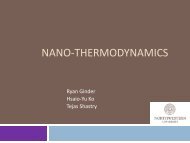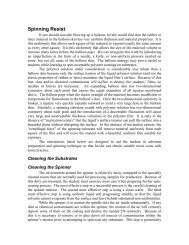A Practical Guide to SPM
A Practical Guide to SPM
A Practical Guide to SPM
You also want an ePaper? Increase the reach of your titles
YUMPU automatically turns print PDFs into web optimized ePapers that Google loves.
21<br />
VII. The Scanner<br />
A piezoelectric scanner is used in virtually all scanning probe<br />
microscopes as an extremely fine positioning element <strong>to</strong> move the<br />
probe over the sample (or the sample under the probe). The <strong>SPM</strong><br />
electronics drive the scanner in a type of zigzag raster pattern, as<br />
shown in Figure 7-1.<br />
While the scanner is moving across a scan line, the data with which<br />
the <strong>SPM</strong> creates the image(s) is sampled at equally spaced intervals.<br />
Figure 7-1. Schematic of piezo<br />
movement during a raster scan.<br />
Voltage applied <strong>to</strong> the X- and Y-<br />
axes produces the scan pattern.<br />
The in-plane (X,Y) spacing between two consecutive data points in a<br />
scan line is called the step size. The step size is determined by the full<br />
scan size and the number of data points per line. In a typical <strong>SPM</strong>,<br />
scan sizes run from tens of Ångstroms <strong>to</strong> over 100 microns and from<br />
64 <strong>to</strong> 1024 data points per line. The number of lines in an image<br />
usually equals the number of data points per line. The image is usually<br />
a square; however, rectangular images, as well as images where the<br />
number of lines and the number of data points per line are not equal,<br />
are also possible.<br />
0V +V -V<br />
No applied<br />
voltage<br />
Extended<br />
Contracted<br />
Electrode<br />
Figure 7-2. The effect of applied voltage on piezoelectric<br />
materials.<br />
X<br />
Z<br />
Y<br />
Y<br />
X<br />
X<br />
Y<br />
Y<br />
X<br />
Z<br />
Metal electrode<br />
Piezoelectric<br />
material<br />
Gnd<br />
Figure 7-3.<br />
Typical scanner<br />
piezo tube and<br />
X-Y-Z configurations.<br />
AC signals applied<br />
<strong>to</strong> conductive areas<br />
of the tube create<br />
piezo movement<br />
along the three<br />
major axes.<br />
How Scanners Work<br />
<strong>SPM</strong> scanners are made from piezoelectric material, which expands<br />
and contracts proportionally <strong>to</strong> an applied voltage. Whether they<br />
elongate or contract depends upon the polarity of the voltage applied.<br />
All Veeco scanners have AC voltage ranges of +220V– -220V for<br />
each scan axis (Figure 7-2).<br />
The scanner is constructed by combining independently operated<br />
piezo electrodes for X, Y, and Z in<strong>to</strong> a single tube, making a scanner<br />
that can manipulate samples and probes with extreme precision in<br />
three dimensions.<br />
In some models (e.g., MultiMode <strong>SPM</strong>), the scanner tube moves the<br />
sample relative <strong>to</strong> the stationary tip. In other models (e.g., STM,<br />
Dimension Series, and BioScope <strong>SPM</strong>s) the sample is stationary<br />
while the scanner moves the tip (Figure 7-3).<br />
X<br />
+V<br />
0<br />
-V<br />
+V<br />
t<br />
Y<br />
+V<br />
0<br />
-V<br />
+V<br />
t<br />
AC voltages applied <strong>to</strong> the different electrodes of the piezoelectric<br />
scanner produce a scanning raster motion in X and Y. There are two<br />
segments of the piezoelectric crystal for X (X and X) and Y (Y and Y)<br />
(Figure 7-4).<br />
X<br />
0<br />
-V<br />
t<br />
Y<br />
0<br />
-V<br />
t<br />
Figure 7-4. Waveforms applied <strong>to</strong> the piezo electrodes during<br />
a raster scan with the X-axis designated as the fast axis (scan<br />
angle = 0°).
















